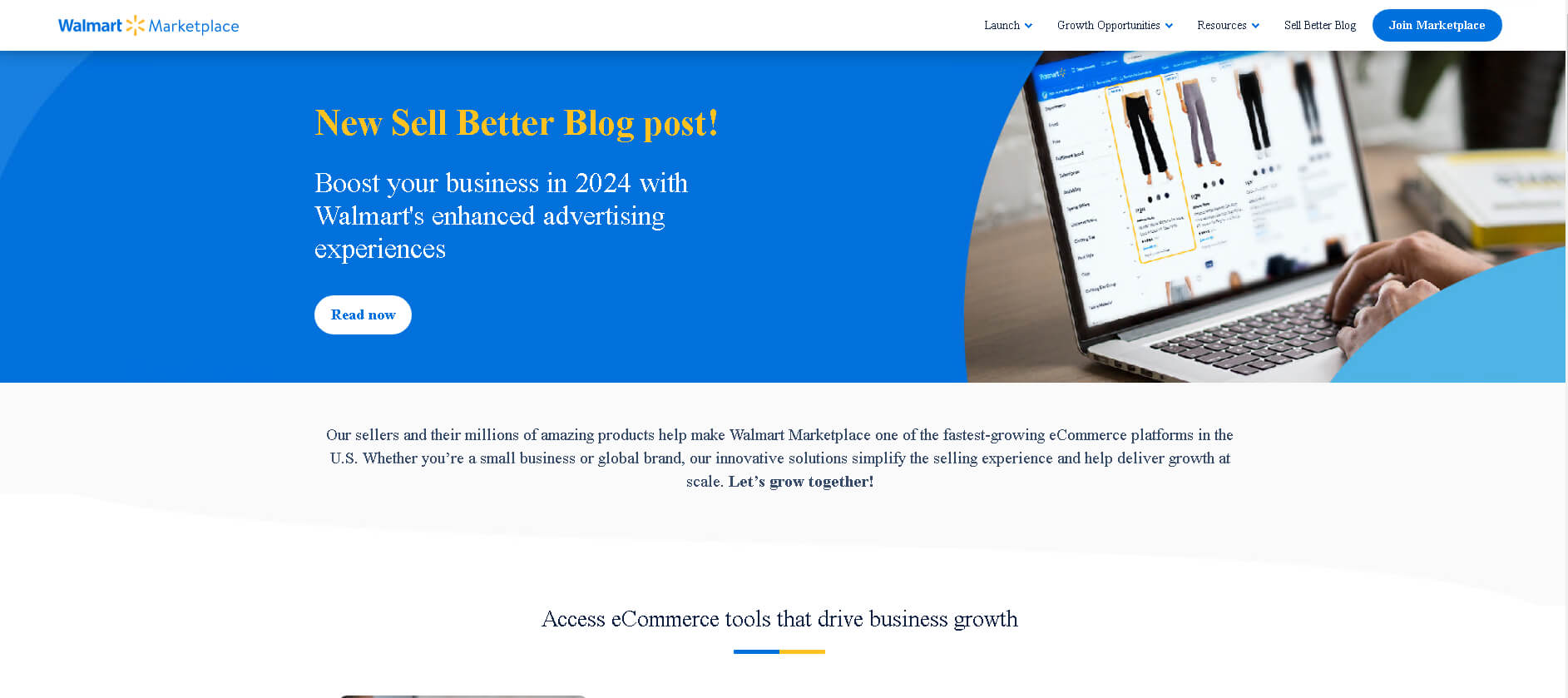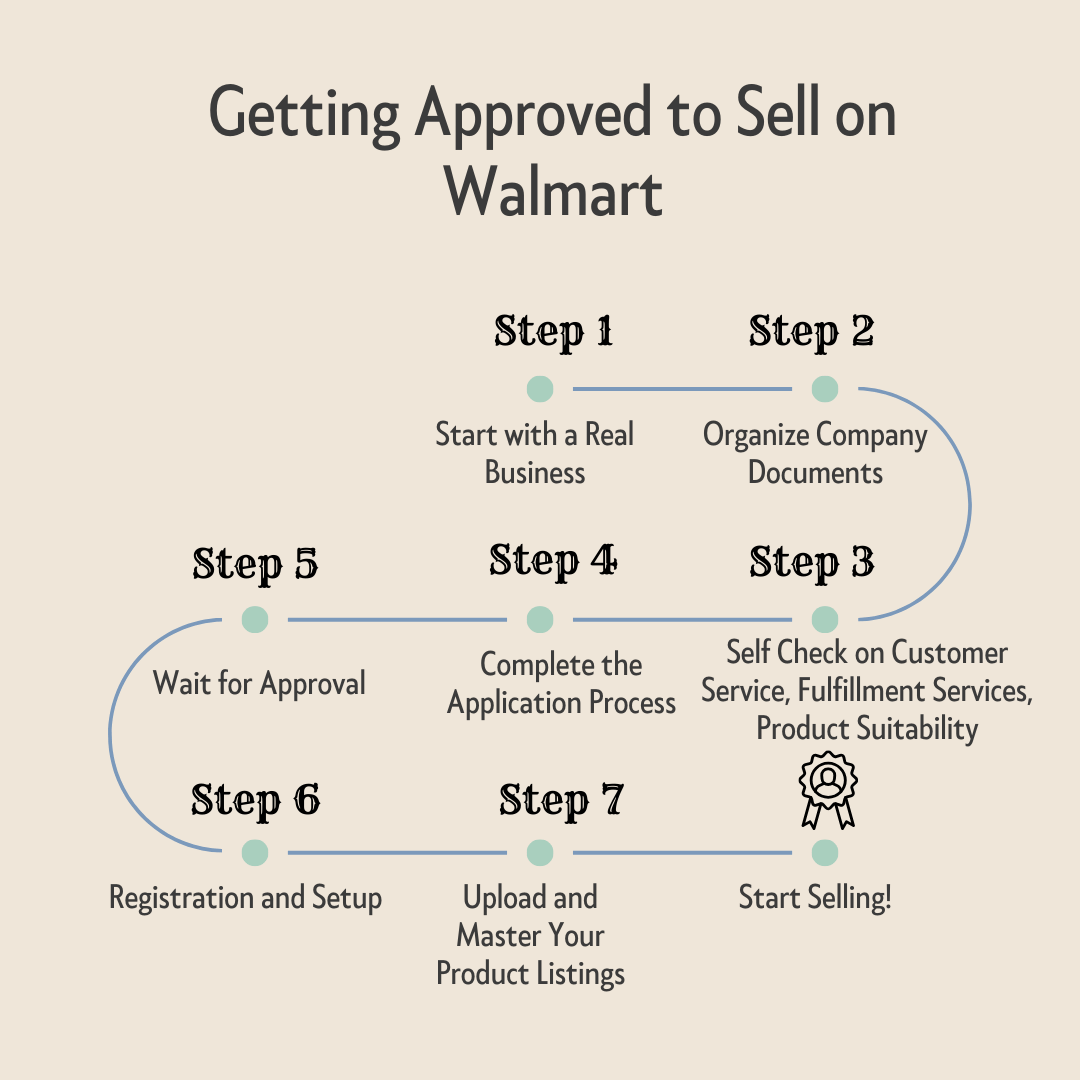
Struggling to get your products listed on Walmart Marketplace? You're not alone. Many businesses find the approval process daunting, facing rejections without clear insights. The good news? This blog post is your solution. We unravel the mysteries of Walmart's approval criteria, guiding you through a streamlined process to successfully list your products on one of the largest retail platforms. Read on to transform your approach and unlock new sales opportunities with Walmart.
Introduction
Walmart Marketplace has become a focal point for e-commerce, evident from its significant growth. By May 2022, the platform boasted over 150,000 sellers, a 66% increase from the previous year. More impressively, its gross merchandise volume tripled in 2020, highlighting Walmart's expanding influence in the online retail space. This surge reflects not only an increase in seller interest but also an expanding customer base seeking diverse products. (Source)
Given this growth, understanding how to get approved to sell on Walmart Marketplace is crucial for businesses looking to tap into this expanding market. This blog post will guide you through the essential steps and criteria for approval, offering insights into making your application stand out. We'll also delve into other key aspects of selling on Walmart, including fee structures, selling strategies, and FAQs to equip you with the knowledge needed to successfully venture into this dynamic marketplace.
What Is Walmart Marketplace?
Walmart Marketplace is a dynamic online platform where businesses can sell their products alongside Walmart's own inventory. It's a digital arena that connects sellers with a vast and diverse customer base, offering a wide range of products from various categories. This marketplace is particularly appealing to entrepreneurs and small business owners, as well as designers, artists, and larger organizations, due to its extensive reach and the reputation of Walmart as a trusted retail brand.
For those looking to expand their online presence, Walmart Marketplace offers an opportunity to tap into a large and engaged audience. Its integration with Walmart's robust logistics and customer service framework provides a seamless shopping experience, making it a lucrative option for sellers. The platform is especially beneficial for those in the print-on-demand sector, offering a vast market for unique and customized products.
How Walmart Marketplace Works?

Navigating Walmart Marketplace involves knowing its operational model, which is centered around facilitating transactions between third-party sellers and customers. Sellers list their products on the platform, where they're made available to Walmart's vast customer base. This process includes managing inventory, processing orders, and providing customer support. It's an opportunity for businesses to access a broader market without the overhead of a physical storefront.
The integration of sellers into Walmart's e-commerce ecosystem is designed to be seamless. This arrangement benefits businesses by leveraging Walmart's established online presence, offering significant visibility and potential for increased sales. Additionally, Walmart Marketplace provides sellers with tools and analytics, aiding them in optimizing their sales strategies and effectively managing their online presence. This setup is especially advantageous for print-on-demand businesses seeking to expand their reach in the e-commerce domain.
Why Sell Your Products on Walmart Marketplace?
Selling your products on Walmart Marketplace offers several strategic advantages, especially for businesses in the print-on-demand sector. Firstly, Walmart's vast and diverse customer base presents a golden opportunity for increased sales and brand exposure. By listing products on this platform, you can reach a wide audience that may not be accessible through other channels.
Additionally, Walmart's reputation as a trusted retail giant lends credibility to your products. This trust factor can be pivotal in convincing customers to choose your offerings over competitors'. Furthermore, Walmart Marketplace provides a structured yet flexible environment for sellers to grow their businesses. With access to Walmart's robust analytics and customer insights, you can make informed decisions to optimize your sales strategies and product offerings. This environment is conducive for entrepreneurs, designers, and small business owners looking to expand their reach in the e-commerce landscape.
What Are Walmart's Criteria for Inviting New Sellers?
Walmart Marketplace has specific criteria for inviting new sellers, focusing on ensuring a high-quality shopping experience for its customers. Key factors include:
- Product Quality and Compliance: Products must meet Walmart's standards of quality and comply with all relevant regulations.
- Competitive Pricing: Pricing should be competitive, offering value to Walmart customers.
- Operational Excellence: Sellers need robust operational capabilities, including efficient fulfillment, inventory management, and customer service.
Additionally, Walmart looks for sellers with a proven track record of marketplace success and positive customer feedback. This reflects Walmart's commitment to maintaining its reputation as a trusted retail platform.
How to Get Approved to Sell on Walmart?
Securing a spot to sell on Walmart Marketplace in 2025 requires a blend of customer service excellence and strategic preparation. Walmart's commitment to customer satisfaction is paramount in their selection criteria for new sellers. However, the journey to partnership goes beyond this initial consideration. For aspiring applicants, it's essential to understand the full scope of Walmart's requirements. Here's a straightforward guide to navigate through the application process:

1. Start with a Real Business:
Ensure your venture is a registered business, especially in the United States. This includes having a U.S. business tax ID, Form W-9, and EIN verification letter.
2. Organize Company Documents:
Ensure all your business documentation is in order, including your U.S. business tax ID, Form W-9, EIN verification letter, and U.S. business and warehouse addresses.
3. Self-Check on Customer Service, Fulfillment Services, Product Suitability:
Ensure that you have robust customer service capabilities, with dedicated business contact numbers and efficient response systems.
Demonstrate your ability to fulfill orders quickly and reliably, adhering to Walmart's shipping requirements.
Confirm that your products are suitable for Walmart's platform, competitively priced, and not listed under the Prohibited Products Policy.
4. Complete the Application Process:
This includes submitting all necessary information and documents on the Walmart Marketplace application page. Make sure to provide detailed and accurate information to avoid delays.
5. Wait for Approval:
The approval process can take between 2 to 4 weeks. During this time, Walmart may contact you for additional information.
6. Registration and Setup:
Once approved, you'll need to register your account, set up payment and shipping information, and complete your partner profile.
7. Upload and Master Your Product Listings:
Use Walmart's Bulk Upload feature or API to upload your products. Ensure your listings are optimized and meet Walmart's standards.
8. Start Selling:
After completing all the steps and meeting Walmart's requirements, you can begin selling on the Marketplace.
How to Increase Your Chances of Getting Approved?
To enhance your chances of getting approved to sell on Walmart Marketplace in 2025, it's crucial to focus on several strategic aspects of your business:
- Uphold Superior Product Standards: Ensuring that your offerings exceed Walmart's quality expectations and fully comply with regulatory demands is fundamental.
- Demonstrate Business Reliability: Illustrate your business's dependability through a consistent history of positive customer reviews and steady sales figures. This aspect reassures Walmart of your capability to maintain their standard of customer satisfaction.
- Adopt Competitive Pricing and Exceptional Customer Service: Walmart values sellers who can offer competitive prices without compromising service quality. Balancing affordability with high-quality customer support can give you an edge in the approval process.
Additionally, Walmart values sellers who can offer a unique product mix or fill a gap in their existing inventory. Showcasing how your products can enhance Walmart's current offerings can be a significant advantage.
How About Walmart Marketplace Fees?
Walmart Marketplace fees are an important consideration for sellers. Unlike some platforms that charge a monthly subscription, Walmart operates on a commission-based model. This means they take a percentage of each sale, which varies depending on the product category.
- Commission Rates: These rates can range from a low percentage for certain categories to a higher percentage for others. It's essential to be aware of how these fees will impact your pricing strategy and overall profit margins.
- No Monthly Fees: Walmart's lack of monthly subscription fees can be advantageous, especially for businesses that are scaling or have variable sales volumes.
Learning Walmart's fee structure is vital for financial planning and strategizing your sales approach on this platform. It's essential for entrepreneurs and business owners to factor these fees into their pricing to ensure profitability while remaining competitive in the marketplace.
How to Sell Products in Walmart Stores?
Selling products in Walmart stores offers an incredible opportunity for visibility and growth. However, it's important to grasp the process to get your products on their shelves. Here's a step-by-step guide on how to navigate this journey:
- Apply for Walmart Marketplace: Initially, apply online for the Walmart Marketplace. This step involves providing detailed business information, including your history, sales figures, and product details. Walmart is selective, seeking partners that align with their customer base and corporate values.
- Showcase Your Unique Offerings: Highlight what sets your products apart. Walmart looks for items that can either fill a gap in their existing inventory or outshine current offerings in terms of quality or price. Unique, innovative products have a better chance of catching their attention.
- Prepare for Compliance and Quality Standards: Walmart maintains high standards for quality and compliance. Ensure your products meet all relevant safety standards and regulations. You might need to provide proof of compliance and undergo a quality assurance process.
- Optimize for Competitive Pricing and Logistics: Competitive pricing is key. Analyze the market and price your products competitively. Additionally, Walmart values efficient logistics. Demonstrate your capability to handle large orders and maintain consistent stock levels.
- Engage in the Onboarding Process: Once approved, you'll go through an onboarding process. This includes setting up your account, attending training sessions, and integrating your product catalog with Walmart's system. Take this phase seriously as it sets the foundation for your success on the platform.
By following these steps, your products can find a place in Walmart's vast retail landscape. Remember, persistence and attention to detail are vital in this process. Walmart's platform can catapult your brand to new heights, making the effort well worth it.
Conclusion
Gaining approval to sell on Walmart Marketplace represents a significant opportunity for businesses in various sectors. As the marketplace continues to grow, positioning your products on this platform can lead to increased visibility and sales. The key to success lies in understanding Walmart's criteria and ensuring that your products and business operations align with their standards. It requires a commitment to quality, competitive pricing, and efficient logistics. By adhering to these guidelines and preparing a thorough application, businesses can leverage the potential of Walmart's vast customer base and robust e-commerce infrastructure.
Looking to the future, Walmart Marketplace remains a dynamic avenue for expanding your business's online presence. The platform's growth trajectory and evolving customer base provide a fertile ground for sellers to thrive. For those ready to undertake this venture, the effort put into meeting Walmart's standards and integrating into their system can yield significant returns. Embrace the opportunity to showcase your products on one of the world's largest retail platforms and tap into the potential of a global marketplace.
FAQs
Who can join Walmart?
Walmart Marketplace is open to a diverse range of sellers, including established businesses, entrepreneurs, innovative brands, and even smaller niche companies. To join, sellers must demonstrate a commitment to quality, competitive pricing, and efficient customer service. This inclusivity allows a variety of businesses, from large organizations to individual artists and dropshippers, to tap into Walmart's extensive customer base.
Can individuals sell on Walmart?
Currently, Walmart Marketplace primarily focuses on businesses and established sellers rather than individual sellers. This platform is ideal for businesses, brands, and organizations with a proven track record of sales and customer satisfaction. Individuals, particularly those without an established business entity, might find it challenging to meet the platform's criteria for sellers.
Is it hard to get approved to sell on Walmart?
Getting approved to sell on Walmart can be challenging due to their selective criteria, focusing on product quality, competitive pricing, and operational efficiency. It's particularly suited for businesses that can align with Walmart's high standards and large-scale operational demands. The process is streamlined but demands thorough preparation and a strong track record in marketplace sales and customer satisfaction.
Why is Walmart seller application denied?
Walmart Marketplace applications are often denied due to factors such as not meeting their stringent quality standards, lack of competitive pricing, insufficient operational capabilities, or non-compliance with regulations. They seek sellers with a proven track record, emphasizing the importance of reliability and customer satisfaction in their evaluation process. It's crucial for applicants to thoroughly prepare and align with Walmart's expectations.
How long does Walmart seller verification take?
The verification process for Walmart seller applications typically takes a few weeks. This timeframe can vary depending on the complexity of your business and the completeness of your application. Walmart thoroughly reviews each application to ensure adherence to their standards, so it's important to provide detailed and accurate information to facilitate a smoother verification process.
How much does it cost to sell on Walmart Marketplace?
Selling on Walmart Marketplace involves commission-based fees, where Walmart takes a percentage from each sale. This rate varies depending on the product category. There are no monthly subscription fees, making it a cost-effective option, particularly for businesses with fluctuating sales volumes. Understanding these commission rates is crucial for pricing strategies to ensure profitability while remaining competitive.










 Global Shipping
Global Shipping




























